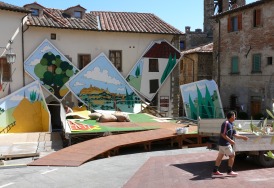Donizetti – LÕelisir dÕamore

Nemorino
– John-Colyn Gyeantey
Adina
– Alinka Kozari
Belcore
– Gary Griffiths
Il
Dottor Dulcama – John Savournin
Giannetta
– Rhona McKail
Southbank Sinfonia/ Simon Over
Director
– Stuart Barker
Designer
– Stuart Targett
Anghiari
Festival
26
July 2008
The 1830Õs were golden
years for opera: in 1831 Auber, collaborating with his great librettist Scribe,
had a success with an opera entitled Le Philtre and within months Donizetti had commissioned
Romani to produce an Italian version, counterpointing the comedy with elements
of pathos and transferring it to the composerÕs native countryside.
Approached by a long straight road
across the fertile Upper Tiber Valley, Anghiari is perched in isolation on a
steep escarpment, with invincible stone walls enclosing the medieval fortress
town. Clearly it would have had a
resident militia, ready to be sent out to fight elsewhere if required, but the
remainder of the rustic population of a place somewhat off the beaten track
could be forgiven for theirexcitement at the arrival in their midst of the
flamboyant Doctor Dulcamara, peddling his Ōmirabile liquoreĶ.
Even today the steeply
sloped cobble-streets within the walls twist and intertwine like a maze,
finally allowing the visitor to reach the 12th century
Piazza del Popolo, perforce on foot. Here a simple platform stage had been constructed to present
the opera directly to the townspeople and appropriately drawing the surrounding
buildings into the set. with director Stuart Barker and designer Stuart Target taking
inspiration from the locale.
TargetÕs sets reflected
the simple pleasures of the Tuscan landscape and his costumes were cleverly colour-themed. Royal blue and scarlet for the militia,
Dulcamara exotic in purple and pink, harvest combinations for the peasants
(with the credulous Nemorino appositely in green), and the beautiful Adina
showed off a succession of drop-dead gorgeous frocks.
I have been a fan of
BarkerÕs direction for several years; his faithfulness to the score and
scrupulous attention to detail is combined with a flair for stretching his singers
to really inhabit their
characters, and coaxing out a performance with more than a touch of magic about
it. He revels in playing
straight to the audience and with the orchestra situated to one side, we were
close enough to take in every blink of the eyelid. Whether watching principals or chorus, it was obvious that
we had a cast of genuine individuals in front of us.
But, of course, LÕelisir is an opera so I should focus on the singing. John-Colyn Geantey (Nemorino) whilst
bringing a delightful naivety to his role, has a tenor voice of velvety
smoothness which he uses to good effect.
Tentatively love-sickin his opening cavatina Quanto e bella, his confidence built with the bogus elixir in Esulti
pur la Barbara, to climax in the
unashamedly sentimental Una furtiva lagrima with its haunting bassoon obligato and mood swings
from minor to major key.
He was well matched by the
Adina of Alinka Kozari, who is capable of bringing a tear to many an eye, a young Hungarian soprano to watch out for. She has
an engaging stage presence combined with a voice of great clarity and totally
secure coloratura. During the
performance she mellowed from haughty indifference to Nemorino to heart-melting
concern that she might have lost him.
All her arias were delivered with aplomb – but IÕll admit to being
a sentimentalist at heart and choose Prendi, me sei libero as favourite.
She also flirted
outrageously both with the Belcore of Gary Griffiths (his cornflower blue eyes
and flashing teeth reinforcing his desirable military status and the occasional
rough edge in his voice was entirely in keeping with his macho nature) and the
Dulcamara of John Savournin (a truly quixotic characterisation, equally
ostentatious in marketing his potions Udite, udite, o rustici and in his impromptu duet with Adina Io son
ricco, tu sei bella delivered at
breathtaking speed.
Rhona McKail (Giannetta)
appeared to be in her element as the ring-leader of the village girls, and the
sequence in which she revealed that NemorinoÕs uncle had died leaving him as
heir and the subsequent all out struggle for his affection was amongst the high
points of the evening. The
combined chorus of UK based student soloists and Anghiari residents gave their
all – both singing with full throated enthusiasm and portraying individual
vignettes.
The orchestra was placed flanking
the stage and whilst Simon OverÕs conducting was always sympathetic, the
spirited playing of the Southbank Sinfonia occasionally sounded over-prominent
towards that side of the square.
Serena Fenwick